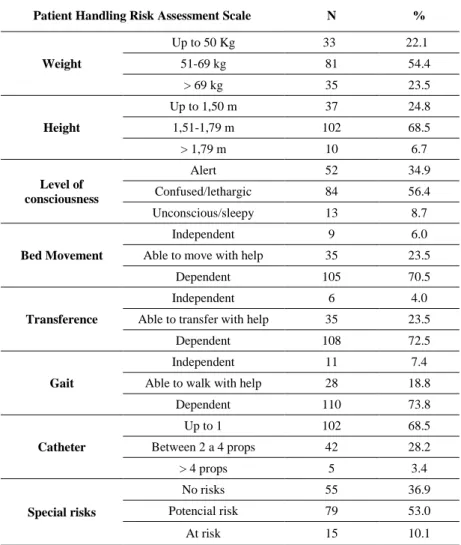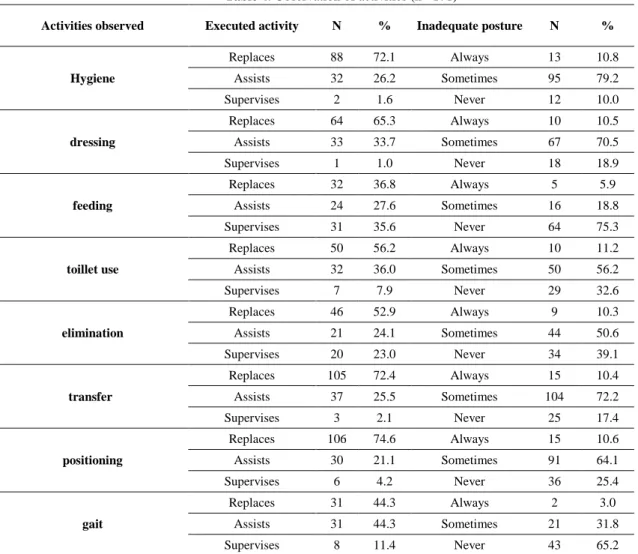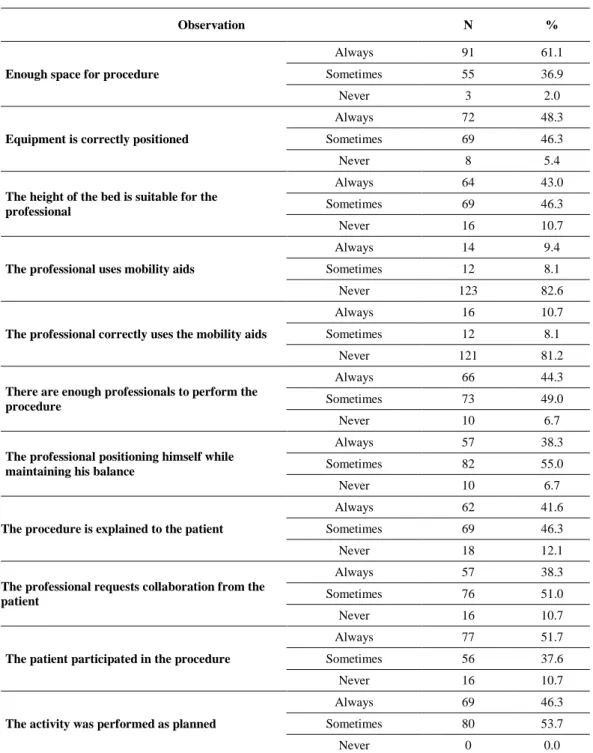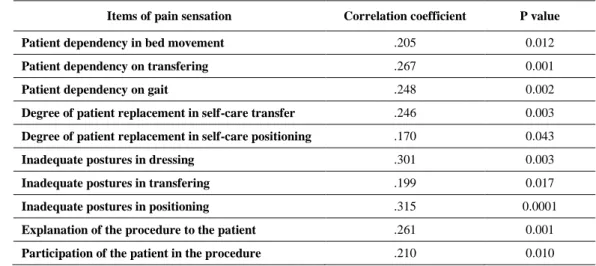Nurs Pract Today. 2018;5(4):385-394.
Original Article
Risk observation in the handling of dependent patients in health professionals of a hospital unit
Carla Sílvia Neves da Nova Fernandes1*, Germano Couto 1,2, Rogério Carvalho2,3, Daniela Gomes Fernandes2, Lídia Brito2, Patrícia Carvalho2, Patrícia Fernandes Ferreira2
1 School of Health, University Fernando Pessoa (UFP), Porto, Portugal
2 Hospital of University Fernando Pessoa (HE-UFP), Porto, Portugal 3
School of Science and Technology, University Fernando Pessoa (UFP), Porto, Portugal
ARTICLE INFO ABSTRACT
Received 29 June 2018 Revised 28 July 2018 Accepted 06 August 2018 ePublished 13 October 2018 Published 07 December 2018
Available online at: http://npt.tums.ac.ir
Background & Aim: There is a high incidence of work-related musculoskeletal injuries in health professionals, namely nurses and nursing assistants, especially associated with the handling and transfer of dependent patients. The present study intends to evaluate the risks of injuries of the health professionals through the observation of the handling of dependent patients.
Materials & Methods: A descriptive and correlational study was performed using the observation of the care provided by nurses and nursing assistants. This study was developed in a hospital of the City of Gondomar-Portugal, data collection was carried out between January and March 2018. 149 Professionals were selected by convenience. The data collected were analysed using IBM SPSS® Statistics version 24.0.
Results: The sample consisted of 149 participants, mostly female. Concerning the assessment of the burden associated with the handling of dependent patients, it was considered excessive by 74.5% of the professionals. Regarding the application of the Graça Risk Assessment Scale (2008), only 7% of the activities were considered low risk. Risk behaviours associated with inadequate space during the procedure, equipment not properly positioned, almost non-use of mobility aids, and failure to use the patient's collaboration to reduce the effort associated with the procedure were observed.
Conclusion: The knowledge obtained through this study will allow the implementation of strategies to reduce the likelihood of pain and musculoskeletal injury related to work.
Key words: nurses,
musculoskeletal diseases, risk reduction behaviour, moving and lifting patients
Introduction1
Work-related musculoskeletal injuries represent a major problem worldwide, particularly in health professionals (1-11). It is known that physical risk factors of health professionals include activities in the workplace, such as load handling, frequent bending and twisting, excessive force and poor working posture (12-14). These activities are developed by nurses and nursing assistants in the care provided to their patients. Nursing care in Portugal is carried out by nurses, with the preparation of the nursing assistants, or delegated to the
* Corresponding Author: Carla Sílvia Neves da Nova Fernandes, Postal Address: School of Health, University Fernando Pessoa (UFP), Porto, Portugal. Email: csfernandes@ufp.edu.pt
nursing assistants when they are considered adequate after evaluation by the nurse. The inadequate use of body biomechanical
capacity, associated to facilitation
techniques, increases the likelihood of work
related musculoskeletal diseases that
represents one of the major work-related problems for health professionals (15). Health care delivery by nurses and nursing
assistants implies patients handling,
involving their own movement in certain circumstances, which entails the risks for health professionals, i.e., the risk of lower back injury (5, 10, 11).
Nurses and nursing assistants have a higher prevalence of lower back injuries (10, 11, 12, 16, 17), associated with patient assistance in their various self-care needs.
These health care tasks require, in most cases, extreme joint positions with force applications, as well as demanding, at spine’s level and, particularly, the lower back (2). The use of inadequate and
physically strenuous methods in patient handling combined with poor awareness of the use of mobility aids leads to an increase of occupational injuries in this work group (12, 16).
Health care providing settings are increasingly dynamic work environments that benefit from strong organizational programs, policies and practices around risk identification and reduction (14) in order to combat this scourge with a strong impact on the worker, but also on the own institutions. It is important to identify and monitor the variables associated with workers risk behaviours. However, procedures associated with the handling of dependent patients are often classified as complex by the variety of components that make up this process (15). Health professionals are a vulnerable group, and suffer more musculoskeletal injuries than other occupational groups, being subject to a higher risk (11). These injuries
represent a significant burden on
organizations, but also on the workers themselves (10).
In the case of hospitals, patient handling is very frequent and involves complex tasks with an impact on the musculoskeletal system (1, 10, 11). These tasks include
hygiene care, treatments, feeding,
placements, transfers, among others (1, 11, 15, 16).
The studies reveal the need for methodologies that focus on the actual observation of ergonomic risk factors in the physical work environment of the health units (10,11,14), which guided this research whose objective is to evaluate the risks of injuries of health professionals by observing the handling of dependent patients.
Methods
A descriptive and correlational study was performed using the observation of the care provided by nurses and nursing assistants. Observation can be a useful tool to identify and predict risks in workplaces and implement corrective actions (14), in support of the highly acclaimed "quality" in
which the health of health professionals is embedded (5). The use of ergonomic analysis tools can identify, in existing environments, areas that need improvement and thereby reduce the likelihood of work-related musculoskeletal pain and injury (14).
This study was developed at a hospital of the City of Gondomar-Portugal; data collection was carried out between January and March 2018. This study was carried out through the inclusion of all nurses and nursing assistants with direct patient care in 3 hospital inpatient units, of which 73 were nurses and 76 were operational assistants.
The load Perception Scale (Burden) instrument (15) presents three items to
determine the health professional's
perception of the patient's handling: (a) the effort made in the transfer, (c) time spent on the transfer. The answer to each of the questions is presented in the five-point Likert format (None, Some, Moderate, Very, Very Much) where the value 1 represents zero intensity and the value 5 is the highest Previously a meeting was held with the heads of the service to present the study,
objectives and instruments of data
collection. The researchers who carried out the research are specialists in rehabilitation nursing and have resorted to a direct and
participant observation. Participant
observation was used as a methodology for data collection, which allows informal relations between the observed subjects and the researcher to be found in the search for the practices performed, collecting elements that would not be (well) captured by other investigative techniques (18). Participant observation is useful for understanding behaviours, using in situ observation of the phenomena to be understood (19). The data collection was performed through the application of instruments used during the observation period.
intensity. The scale has a minimum value of 3 and maximum of 15 According to the author of the scale, The Load Perception Scale (Burden), values ≥6 points are defined as positive or high load (15).
At the level of internal consistency, the load perception scale (Burden) presented a Cronbach's alpha value of α = 0.628 lower than that of the author α = 0.781(15).
It was also used The Patient Handling Risk Assessment scale. The scale was originally validated for application in the Brazilian context (20) and later in the Portuguese context (15). Presents eight items that include: weight; height; level of consciousness; mobility dependency in bed; transfer dependency; walking dependency; use of catheters or equipment, and special risks associated with the environment. In this instrument each item varies between one and three points. The sum of the points of each item allows determining the total score and the respective risk category for musculoskeletal injury, characterized as low risk (8-12), medium risk (13-18) or high risk (19-24). Weight data are given in kilograms. The special risks relate to environmental issues, flooring, sufficient space and unexpected obstacles. The identification of the factors that contribute to injuries occurrence implies the decomposition of the work in the different successive events that constitute it, allowing the observation of the details and the understanding of the interaction between these factors. With this purpose, a grid was built to observe
activities. The instrument built for
observation incorporates 8 items referring to the degree of professional participation (in levels) in care activities as hygiene, clothing, feeding, sanitary use, disposal, transfer, positioning and walking. Incorporates 8 items to identify inappropriate postures in care activities as hygiene, clothing, feeding sanitary use, disposal, transfer, positioning and walking, and lastly 12 items related to encouraging patient collaboration (3 items),
use of technical aids), equipment
adjustment, activity planning (3 items) and
body mechanics (3itens). All these are scored with a 3 point Likert range. The University's Ethics in Research Committee approved this study with No 432017. The researchers ensured ethical issues based on the Declaration of Helsinki. Data collection was performed after explaining the purpose of this study and obtaining the informed consent of the participants. All individuals were informed about the information and the right to refuse participation or withdraw from the study at any time. The descriptive statistics and variance used to the data analysis using the IBM SPSS Statistics for Windows, Version 24.0. Data were analysed using descriptive and analytical statistics and p<0.05 was considered significant.
Results
171 observations were made to 149 professionals, 73 nurses and 76 nursing assistants. Most of the participants are female (nurses: 15% male, 85% female; ursing assistants: 8% male, 92% female,), age ranged from 19 to 63 years (nurses: 23- 63 years old, nursing assistants: 19-56 years old). A total of 171 observation moments were performed between January and March 2018 among the professionals (N=149) of the three inpatient services (Unit 1: N=16 Nurses, N=19 Nursing
assistants; Unit 2: N=32 Nurses, N=31 Nursing assistants; Unit 3= Ward 1: N=25 Nurses, N=26 Nursing assistants) (Table 1).
In table 2 we can observe the different dimensions of the load rating scale by professional group, observing that the type of effort is high in each of the professional groups.
In a more detailed analysis of the dimensions evaluated in the Load Perception Scale (Burden) it can be seen in table 2 that the perception of the type of physical effort performed in the handling of patients is high and is almost always considered with effort. Similarly, all of these procedures cause pain, and exposure to this type of procedure is felt to be long from the point of view of its duration.
Considering, like the author of the Load The high degree of patient dependency is also visible in Table 4 due to the observation of the activities carried out by the participants, highlighting the high percentage of the a high degree of assistance of the patient in the majority of self-care, evidencing the high physical overload, i.e., hygiene (72.1%), dressing (65.3%), transfer (72.4%) and positioning (74.6%).
On the other hand, it is precisely in this
self-care that a greater number of
inappropriate postures are observed (hygiene (always 10.8% and sometimes 79.2%), dressing (always 10.5% and sometimes 70.5%), transfer (always 10.4% and sometimes 72.2%) and positioning (always 10.6% and sometimes 64.1%).
Table 5 shows the variables observed in the execution of the procedures by the participants. This observation with an ergonomic focus integrated aspect related to body mechanics, the interaction between the health professional and the patient, and between the health professional and the environment. This last level included the observation of the health professional resource to available mobility aids. Some risk behaviours are noted in the table, namely the lack of adequate space for the procedure (sometimes and never 38.9%), the fact that the equipment is not properly
Profession (N=149) Unit 1 Unit 2 Unit 3
Nursing assistants Nurse 19 16 31 32 26 25 Total 35 63 51 Dimensions
Nurses Nurses assitant Global
Mean± SD Mean± SD Mean± SD
Effort perception 3.01± 0.129 2.95± 0.126 2.99± 0.09 Sensation of pain 1.6± 0.089 1.49± 0.089 1.54± 0.063 Perceived overuse of the
procedure 2.63± 0.134 2.72± 0.126 2.68± 0.092
Table 1. Participants by units
Table 2. Values and dimensions of the load perception scale by professional group
When calculated the scale’s total score, observed by researchers, there is a high risk associated with the handling of more frequent patients at medium risk (77%), with the low risk present in only 7% of cases, and 16% with high risk.
Perception Scale (Burden) (15), values greater than or equal to six points to define as positive the perception of load related to the handling of the dependent person, approximately 74.5% of the procedures remained included in this category, which is high value. In the Patient Handling Risk Assessment Scale, an overall scale average was 16.64 (SD = 2.218), with a maximum of 20 points and a minimum of 11 points. It is recalled that the scale has total amplitude of 8 to 24, with the midpoint being about 16. With regard to internal consistency, the Patient Handling Risk Assessment scale presented a Cronbach Alpha value of α = 0.689 lower than that of the author α = 0.770 (15).
In Table 3, referring to the descriptive statistics of the Patient Handling Risk Assessment Scale, there is a high degree of
patient dependency (Bed Movement
Dependency 70.5%, Transfer Dependency 72.5%, and Gait Dependency 73.5%).
Table 3. Descriptive statistics of the Patient Handling Risk Assessment Scale observed by researchers
Patient Handling Risk Assessment Scale N %
Weight Up to 50 Kg 33 22.1 51-69 kg 81 54.4 > 69 kg 35 23.5 Height Up to 1,50 m 37 24.8 1,51-1,79 m 102 68.5 > 1,79 m 10 6.7 Level of consciousness Alert 52 34.9 Confused/lethargic 84 56.4 Unconscious/sleepy 13 8.7 Bed Movement Independent 9 6.0
Able to move with help 35 23.5
Dependent 105 70.5
Transference
Independent 6 4.0
Able to transfer with help 35 23.5
Dependent 108 72.5
Gait
Independent 11 7.4
Able to walk with help 28 18.8
Dependent 110 73.8 Catheter Up to 1 102 68.5 Between 2 a 4 props 42 28.2 > 4 props 5 3.4 Special risks No risks 55 36.9 Potencial risk 79 53.0 At risk 15 10.1
positioned (sometimes and never 51.7%), such as the bed height (sometimes and never 60%), low use of mobility aids (sometimes and never 90.7%) and low recourse to patient collaboration (sometimes and never 61, 7%) to reduce the physical burden associated with the procedure.
Table 6 illustrates the pain feeling during the procedure, where we can observe the relationship with the patient's degree of dependency on handling, transferring and gait. The pain feeling during the procedure also correlates with the degree of assistance (low, medium and high) in transferring and positioning, as well as with inappropriate postures in dressing, transferring and positioning. Finally, it is verified that there
are statistical correlations when the
procedure is explained to the patient and when it is possible to participate.
Discussion
The aim of this study is to evaluate the risk of injuries to health professionals through observation of the handling of dependent patients. Through the application of the load perception scale, it was observed that it was considered excessive in 74.5% of the procedures, which is in line with the results obtained by Graça (2013) (15). It is important to note that little has been reported about health workers' perception of "self-risk" in work-related musculoskeletal injuries (21). However, Lee et al. (2017) report that health professionals' perception of risk has not been shown to influence adherence to safe behaviours (22). Some nurses and nursing assistants recognize the potential risks to themselves, but at the time of the procedure they choose the path that seems quicker and do not require peer help (21).
Regarding the different dimensions of the scale, the perception of effort in the procedure is visible in 92.6% of the cases, as well as the excess time associated with the procedure (80.5%), similar results were obtained by Graça (2013) (15).
It is worth noting that in 61.1% of the situations the procedure is performed with pain. of the studies on the reported prevalence of pain in nurses and nursing assistants, the high levels of pain that have been experienced over a year, with higher levels in the lower back, shoulder and neck region are visible (8).
score obtained is mostly high, associated with a high degree of patient dependency, where only 7% of the observations were considered low risk. Manual handling of the patient is known to be the main source of musculoskeletal load among nurses in hospital units. Abedini et al (2015), in a study with 400 nurses, although using a separate assessment instrument, showed that 83.5% of the subjects were exposed to the risk of musculoskeletal injuries, of which 20% were at high risk (12).
Some risk behaviours that interfere with body alignment and the position of the various anatomic segments during the
procedure are highlighted, especially
associated with inadequate space during the
procedure, not properly positioned
equipment, and the almost non-use of mobility aids and failure to use patient collaboration to reduce the effort associated with the procedure.
Activities observed Executed activity N % Inadequate posture N %
Hygiene Replaces 88 72.1 Always 13 10.8 Assists 32 26.2 Sometimes 95 79.2 Supervises 2 1.6 Never 12 10.0 dressing Replaces 64 65.3 Always 10 10.5 Assists 33 33.7 Sometimes 67 70.5 Supervises 1 1.0 Never 18 18.9 feeding Replaces 32 36.8 Always 5 5.9 Assists 24 27.6 Sometimes 16 18.8 Supervises 31 35.6 Never 64 75.3 toillet use Replaces 50 56.2 Always 10 11.2 Assists 32 36.0 Sometimes 50 56.2 Supervises 7 7.9 Never 29 32.6 elimination Replaces 46 52.9 Always 9 10.3 Assists 21 24.1 Sometimes 44 50.6 Supervises 20 23.0 Never 34 39.1 transfer Replaces 105 72.4 Always 15 10.4 Assists 37 25.5 Sometimes 104 72.2 Supervises 3 2.1 Never 25 17.4 positioning Replaces 106 74.6 Always 15 10.6 Assists 30 21.1 Sometimes 91 64.1 Supervises 6 4.2 Never 36 25.4 gait Replaces 31 44.3 Always 2 3.0 Assists 31 44.3 Sometimes 21 31.8 Supervises 8 11.4 Never 43 65.2
Table 4. Observation of activities (n= 171)
The prevalence of low back pain in nurses and nursing assistants is very high, and is the main cause of absence due to occupational disease in this group. Low back pain has been the subject of extensive research and is traditionally attributed to the high physical demands of care (16). In the patient handling risk assessment scale the
Table 5. Variables observed (n=171)
Observation N %
Enough space for procedure
Always 91 61.1
Sometimes 55 36.9
Never 3 2.0
Equipment is correctly positioned
Always 72 48.3
Sometimes 69 46.3
Never 8 5.4
The height of the bed is suitable for the professional
Always 64 43.0
Sometimes 69 46.3
Never 16 10.7
The professional uses mobility aids
Always 14 9.4
Sometimes 12 8.1
Never 123 82.6
The professional correctly uses the mobility aids
Always 16 10.7
Sometimes 12 8.1
Never 121 81.2
There are enough professionals to perform the procedure
Always 66 44.3
Sometimes 73 49.0
Never 10 6.7
The professional positioning himself while maintaining his balance
Always 57 38.3
Sometimes 82 55.0
Never 10 6.7
The procedure is explained to the patient
Always 62 41.6
Sometimes 69 46.3
Never 18 12.1
The professional requests collaboration from the patient
Always 57 38.3
Sometimes 76 51.0
Never 16 10.7
The patient participated in the procedure
Always 77 51.7
Sometimes 56 37.6
Never 16 10.7
The activity was performed as planned
Always 69 46.3
Sometimes 80 53.7
Never 0 0.0
According to Carneiro et al. (2015) the risk
factors that most contribute to the
development of Work-related musculoskeletal disorders are load distance, asymmetric load, postural constraints, back/ lateral flexion and obstacles in movement (6). The use of equipment and mobility aids may minimize the compressive forces in the spine; however its use was not visible in this study. As some authors refer to the acquisition of mobility aids, it does not guarantee by itself the proper use of these tools (14, 21, 23). The most
frequently cited causes for non-use of patient transfer assistance devices are related to time constraints and difficult situations in patient handling. These factors lead to infrequent use of mobility aids, especially mechanical devices that are not readily available (23). Throughout this study, correlations were found between the pain feeling and inadequate postures in assistance to dressing, transferring and positioning, which could be remedied by the use of available mobility aids.
Table 6. Correlations of pain during observed procedures
Items of pain sensation Correlation coefficient P value
Patient dependency in bed movement .205 0.012
Patient dependency on transfering .267 0.001
Patient dependency on gait .248 0.002
Degree of patient replacement in self-care transfer .246 0.003
Degree of patient replacement in self-care positioning .170 0.043
Inadequate postures in dressing .301 0.003
Inadequate postures in transfering .199 0.017
Inadequate postures in positioning .315 0.0001
Explanation of the procedure to the patient .261 0.001
Participation of the patient in the procedure .210 0.010
However, one aspect of the hospital environment that is particularly difficult to change is the deeply rooted beliefs and attitudes around environmental health and safety practices. These beliefs may prevent the change of new policies and practices, namely those related to the safe handling of patients, particularly the use of mechanical lifts (14).
Multiple approaches are needed to drive changes in practice that promote a safety culture, including workflow processes, ongoing training, and skills monitoring. It is necessary to encourage in the units the choice of facilitators to teach, change behaviours and to monitor the appropriate use of mobility aids (21). It is recommended that adequate training programs be developed to improve the knowledge and skills of the nursing staff in the handling of dependent patients (12), with annual training on appropriate techniques for patient/load handling, in order to work neutral level of the lower back (6). The lack of knowledge and skills for the use of mobility aids is pointed out as a barrier in the adoption and implementation of safe practices (21). Finally, interventions should take into account not only the ergonomics, but also the improvement of the organizational aspects of the work environment (16), enhancing patient participation in the procedures, previously planning the activity by unblocking the space around the patient's bed, ensuring an optimization of the interaction between the health professional and the patient and between the health professional and the environment
(6). Some limitations of this study should be pointed out. Firstly, because the data were collected by different researchers. Second, this study was limited to the intern services in question and restricted to previously stipulated items. The knowledge obtained through this study will allow the implementation of strategies to reduce the likelihood of pain and musculoskeletal injury related to work.
Conclusions
The results of this study provide new information on the complexity of the risks associated with the handling of dependent patients in hospital units through an observational study. The perception of burden and risks associated with the handling of dependent patients was high in both
professional groups. The degree of
dependency and degree of assistance of patients from the different units under study constitute an overload for which strategies are needed to minimize physical overload. In observed assistance some risk behaviours are noted that can and should be corrected through the implementation of systemic and multifactorial programs. The results of the
study highlight the importance of
implementing a culture safely to ensure safe behaviours in the handling of patients and the need to promote the use of mobility aids.
The methodology used allowed the identification of factors that could hardly be reached through other strategies of data
collection. Participant observation proved to be an adequate tool to deepen the phenomenon under study, although, given the dynamics of hospitals, it would be important to develop simpler tools that require less time and resources to continuously monitor the physical work environment and thereby achieve the reduction of risks. It is proposed that further longitudinal studies be conducted including monitoring of other occupational health groups.
Acknowledgments
We are grateful to all the participants of the study, who have allowed us to carry out this journey, as well as to the entire University and Hospital community, for always promoting a perspective of continuous improvement, in the search for excellence of care.
Conflict of interest
The authors declare no conflict of interest.
References:
1. Serranheira F, Sousa-Uva M, Sousa-Uva A. Hospital nurses tasks and work-related musculoskeletal disorders symptoms: A detailed analysis. Work. 2015;51(3):401-9.
2. Serranheira F, Cotrim T, Rodrigues V, Nunes C, Sousa-Uva A. Lesões musculoesqueléticas ligadas ao trabalho em enfermeiros portugueses:«ossos do ofício» ou doenças relacionadas com o trabalho? Revista Portuguesa de Saúde Pública. 2012;30(2):193-203.
3. Yasobant S, Rajkumar P. Work-related musculoskeletal disorders among health care professionals: A cross-sectional assessment of risk factors in a tertiary hospital, India. Indian journal of occupational and environmental medicine. 2014;18(2):75.
4. Yasobant S, Rajkumar P. Health of the healthcare professionals: A risk assessment study on work-related musculoskeletal disorders in a tertiary hospital, Chennai, India. International Journal of Medicine and Public Health. 2015;5(2).
5. Neves M, Serranheira F. A formação de profissionais de saúde para a prevenção de lesões musculoesqueléticas ligadas ao trabalho a nível da coluna lombar: uma revisão sistemática. Revista Portuguesa de Saúde Pública. 2014;32(1):89-105.
6. Carneiro P, Martins J, Torres M. Musculoskeletal disorder risk assessment in home care nurses. Work. 2015;51(4):657-65.
7. Azizpour Y, Delpisheh A, Montazeri Z, Sayehmiri K. Prevalence of low back pain in Iranian nurses: a systematic review and meta-analysis. BMC Nursing. 2017;16(1):50.
8. Davis KG, Kotowski SE. Prevalence of musculoskeletal disorders for nurses in hospitals, long-term care facilities, and home health care: a
comprehensive review. Human factors.
2015;57(5):754-92.
9. Long MH, Bogossian FE, Johnston V. The prevalence of work-related neck, shoulder, and upper back musculoskeletal disorders among midwives, nurses, and physicians: a systematic review. Workplace health & safety. 2013;61(5):223-9. 10. Yassi A, Lockhart K. Work-relatedness of low back pain in nursing personnel: a systematic review. International journal of occupational and environmental health. 2013; 19(3):223-44.
11. Anderson SP, Oakman J. Allied health professionals and work-related musculoskeletal disorders: a systematic review. Safety and health at work. 2016;7(4):259-67.
12. Abedini R, Choobineh A, Hasanzadeh J. Patient manual handling risk assessment among hospital nurses. Work. 2015; 50(4):669-75.
13. Carneiro P, Braga AC, Barroso M. Work-related musculoskeletal disorders in home care nurses: Study of the main risk factors. International Journal of Industrial Ergonomics. 2017;61:22-8. 14. Grant MP, Okechukwu CA, Hopcia K, Sorensen G, Dennerlein JT. An Inspection Tool and Process to Identify Modifiable Aspects of Acute Care Hospital Patient Care Units to Prevent Work-Related Musculoskeletal Disorders. Workplace health & safety. 2018;66(3):144-58.
15. Graça M, Alvarelhão J, Oliveira A, Almeida R, Martín I. Relação entre percepção de carga e risco de manuseio em idosos dependentes. Psicologia, Saúde & Doenças. 2013;14(1):53-63.
16. Bernal D, Campos-Serna J, Tobias A, Vargas-Prada S, Benavides FG, Serra C. Work-related psychosocial risk factors and musculoskeletal disorders in hospital nurses and nursing aides: a systematic review and meta-analysis. International journal of nursing studies. 2015;52(2):635-48. 17. Leal GMA, Oliveira MRT, de Souza Bastos VC, Barros MdFA, de Carvalho AGC, Campos SL, et al. Study of musculoskeletal disorders in physical therapists: correlation with routine work. Manual Therapy, Posturology & Rehabilitation Journal. 2014;12:191.
18. Fernandes FMB, Moreira MR. Considerações metodológicas sobre as possibilidades de aplicação da técnica de observação participante na Saúde Coletiva. Physis: Revista de Saúde Coletiva. 2013;23:511-29.
19. Perazzo PF. Pressupostos epistemológicos e metodológicos da pesquisa participativa: da observação participante à pesquisa-ação. Estudios sobre las culturas contemporáneas. 2017(3):161-90. 20. Radovanovic CA, Alexandre NM. Validation of an instrument for patient handling assessment. Applied Ergonomics. 2004;35(4):321-8.
21. Kanaskie ML, Snyder C. Nurses and nursing assistants decision-making regarding use of safe patient handling and mobility technology: A qualitative study. Applied Nursing Research. 2018;39:141-7.
22. Lee SJ, Lee JH. Safe patient handling behaviors and lift use among hospital nurses: A cross-sectional study. Int J Nurs Stud. 2017;74:53-60.
Noble NL, Sweeney NL. Barriers to the use of assistive devices in patient handling. Workplace health & safety. 2018; 66(1):41-8.




